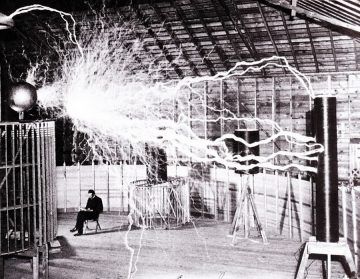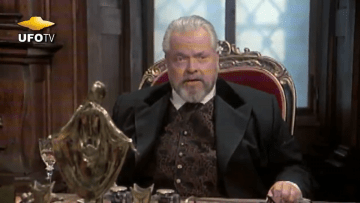by David Kordahl

Many of the best historical movies featuring “hard” scientists have used social problems, rather than than scientific controversies, to propel their action.1 Two recently released films that address the legacy of Nikola Tesla reverse this trend. The Current War, a plummy costume drama whose planned 2017 distribution was delayed by the Harvey Weinstein scandals, mainly addresses the famously public feud between Thomas Edison and George Westinghouse. But at its heart is the question of whether the future of electrical power would run on direct current (DC) or alternating current (AC), a debate that Tesla’s polyphase AC generators eventually won. And the newly released Tesla, a formalist exercise in the postmodern style, takes Tesla’s story farther, leading viewers into his controversial work on wireless power transmission, work that, depending on which parts of the Internet you ask, was either awesomely visionary or deeply confused.
Nikola Tesla (1856-1943) was a truly odd person, the only scientist whose name a hair band and a car company might both want to borrow. It isn’t hard to figure out what has made him a mainstay of popular culture. Had Tesla merely been an inventor of genius, he might have been remembered only by engineers. But Tesla was also an entertainer. My Inventions, a compilation of Tesla’s scattered popular writing, includes many quotes that sound openly anti-scientific. In between his anecdotes about curing personal ailments with his mind and an exposition of his law of compensation (“true rewards are ever in proportion to the labor and sacrifices made”), here’s how Tesla described his method of invention:
When I get an idea I start at once building it up in my imagination. I change the construction, make improvements and operate the device in my mind. It is absolutely immaterial to me whether I run my turbine in thought or test it in my shop. […] When I have gone so far as to embody in the invention every possible improvement I can think of and see no fault anywhere, I put into concrete form this final product of my brain. Invariably my device works as I conceived that it should, and experiment comes out exactly as I planned it.
For a person of sufficient genius applying solidly established scientific principles, this method might work. But where the empirical principles haven’t been firmly established, this seems like a pretty bad method, and Tesla’s later explorations, which pushed ever farther into questions of basic science, were increasingly unfruitful, perhaps as a result of this.
Previous movie depictions of Tesla have been in no hurry to reflect these failures. The Secret of Nikola Tesla, a Yugoslavian production from 1980, recounts Tesla’s life as a campy conspiracy plot, backed by a warbling theater-organ soundtrack. The wizened old Tesla dies alone in his hotel room, wondering why J.P. Morgan won’t return his calls. Morgan, who really was important to Tesla as a funder, is memorably portrayed here by Orson Welles, who appears at times to read his lines off a manila folder.

In The Secret of Nikola Tesla, the titular hero is a messianic wizard, a man who would give free energy to the people if only the capitalist baddies weren’t conspiring to keep him down. A more sinister version of Tesla was portrayed by David Bowie in The Prestige (2004), in which Tesla was able to perform literal miracles for magicians, but not without a cost. These prior visions of Tesla—as a messiah, a magician, a miracle-maker—are what subsequent versions must choose either to embrace, or to cut against.
In The Current War (or The Current War: Director’s Cut—that extra subtitle indicates that Weinstein’s sticky fingerprints have been wiped off), all such fantastical elements have been avoided. The film covers more or less the same story that history buffs can read about in Empires of Light: Edison, Tesla, Westinghouse, and the Race to Electrify the World, Jill Jonnes’ entertaining popular history. In this story, Thomas Edison (Benedict Cumberbatch) is the establishment electrician against whom George Westinghouse (Michael Shannon) must vie. Tesla (Nicholas Hoult) here is but an important supporting player. The Current War is handsomely produced, with frequent closeups and Dutch angles giving an impression of some ambition. As many reviewers noted, it seems to be explicitly modeled after Amadeus, with Edison as Salieri, and Tesla as Mozart. But it doesn’t really work on that level, and gets stuck as an impressive edutainment: good for a day off in history class, but probably not great for film studies.
Were The Current War a blockbuster like Amadeus, historical inaccuracies wouldn’t matter. Some exaggerations, in any case, are to be expected. For instance, when Tesla tells Edison that his motor is only in his mind, it shouldn’t matter to us too much that Tesla had built a working prototype before leaving Europe. The story, though untrue, is in keeping with Tesla’s character. But other depictions seem flawed enough to warrant complaint.
Nicholas Hoult is hard to fault as the victimized Tesla (“You’re just an immigrant looking for a handout,” spits a bad business partner), but he isn’t onscreen very much. The leads are the bigger problem here. Thomas Edison portrayed himself as a sort of hick savant, yet this bumptiousness is obscured by Benedict Cumberbatch’s natural suavity. George Westinghouse is said to have exuded a spirit of perfect temperance, yet this reported calm can be found nowhere on Michael Shannon’s furious face.
A bigger problem still with The Current War is that we aren’t given a sense of what, if anything, really matters in the historical shift that the story dramatizes. Sure, we can recognize that Edison is playing dirty, especially when he promotes “Westinghoused” as the proper description for criminals who have been executed by alternating current in the electric chair. And sure, the fact that Westinghouse adopted Tesla’s system had far-reaching consequences—the three transmission lines at the top of most power poles each carry one of the three phases of a Tesla-style polyphase system. But no one in the film meets an especially tragic end (no one, that is, except for Tesla), and over a century later, the question of who could power the World’s Fair the most cheaply seems like a detail. Sure, the world was changed by the introduction of inexpensive electrical power. But so what?
This question—So what?—seems at least to have occurred to Michael Almereyda, the auteur responsible for Tesla, the new biopic starring Ethan Hawke. Yet the movie is fated to better reviewed than loved, and this is a fair fate. Tesla self-consciously refuses simply to relate the story of Nikola Tesla, and prefers instead to engage us with little postmodern gags. J.P. Morgan’s daughter Anne (Eve Hewson) acts as one of the narrators of the movie, and at one point she opens a laptop and tells us her Google search results. In another scene, after Edison concedes that Tesla was right, he pulls out a smartphone, and the narrator lets us know that this scene never happened. Ethan Hawke is the straight man at the center of this mosaic—until the karaoke sequence at the end, anyway, where he sings “Everybody Wants to Rule the World” off-key in front of an artificially projected sunset.
Frankly, Tesla is a pretty annoying movie. My feeling of irritation toward it was similar to the feeling I had while watching Experimenter: The Stanley Milgram Story (2015), the director’s previous foray into this type of stylized meditation. Without lobbing any complaint about their mixing of digressive essays and dramatized scenes—The Jeffrey Dahmer Files (2012) employed a similar style to great effect—one might still ask, why should these methods merely convey the half-truths of a standard biopic? The horrifying Edison film reel, “Electrocuting an Elephant,” for instance, is included in Tesla as a primary-source entry in the War of the Electrical Currents. Yet this film was taken ten years after the World’s Fair of 1893, the putative end of that particular “war.” So what is this? Is Almereyda confused, or is he just not letting the truth get in the way of a good story?
The answer is almost certainly the latter. Another example of Almereyda’s indifference to facts involves Tesla’s sexual interests. Tesla never married; in Tesla: Inventor of the Electrical Age, biographer W. Bernard Carlson documents that, despite Tesla’s claim that his inventiveness required it, a more straightforward explanation for Tesla’s celibacy may have been that he was attracted to men.2 Yet Tesla focuses on Tesla’s romantic possibilities with women, first with the aforementioned Anne Morgan, and later with the actress Sarah Bernhardt (Rebecca Dayan). These actresses are wonderful to watch, but their inclusion seems misguided when history points elsewhere.
One reason that these oversights are pretty annoying is that other parts of Tesla are pretty great. Thomas Edison and George Westinghouse (Kyle McLaughlin and Jim Gaffigan, respectively), here, are better realized than their counterparts in The Current War, and the material on Tesla after his first triumph manages to locate the tragic heart of the electrical story.
“The world we are living in is a dream that Tesla dreamed first.” This line is delivered by Anne Morgan as the closing statement in Tesla, and it lands when you first hear it even though it’s wrong. After Tesla’s first major triumph with Westinghouse, he turned to work that he supposed would be far more consequential than his polyphase generators, this being his work on wireless power transmission—power transmission, that is, directly through the earth’s crust and through the upper atmosphere. Tesla moved to Colorado Springs (where the iconic double-exposure photo at the top of this post was taken) and found what he supposed to be confirmatory evidence for his ideas. Yet when he attempted a scaled up version of his system at Wardenclyffe, a remote property on Long Island, he failed to deliver what his backer, J.P. Morgan, wanted: global wireless communication. Scooped by Marconi, Tesla soon was cut off by Morgan.
The adventure was over. Eventually, Tesla’s Wardenclyffe lab was scrapped to pay his hotel bills. The world Tesla dreamed of was one where human suffering would be ended by technological means. The world we live in is one that was constructed by practical doers like Edison and Westinghouse, who both, in turn, had their electrical companies taken from them by their financiers. Neither The Current War nor Tesla asks whether the modern world is an entirely good one, or what sort of better worlds are possible. These questions hinge on both social issues and technical prowess, leaving Tesla’s legacy open for future interpreters, and probably for more movies.
1 As a non-exhaustive list, consider A Beautiful Mind (John Nash has a mental illness), The Theory of Everything (Stephen Hawking has ALS), The Imitation Game (Alan Turing faces homophobia), and Hidden Figures (a trio of “human computers” faces racism and sexism). Describing these as “social issues” movies is a little reductive, but it seems more accurate than claiming them as movies about science qua science.
2 Tesla was also fond of pigeons, and once wrote of a special white pigeon who visited his hotel suite, “I loved that pigeon as a man loves a woman, and she loved me. As long as I had her, there was a purpose to my life.” I have no idea what this means (“as a man loves a woman”?) and am happy to leave it as a mystery.
